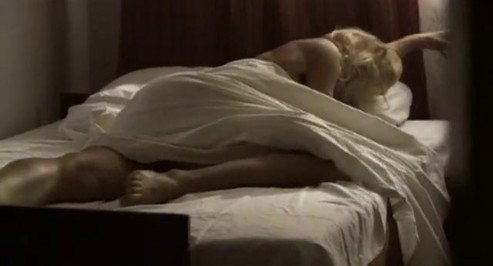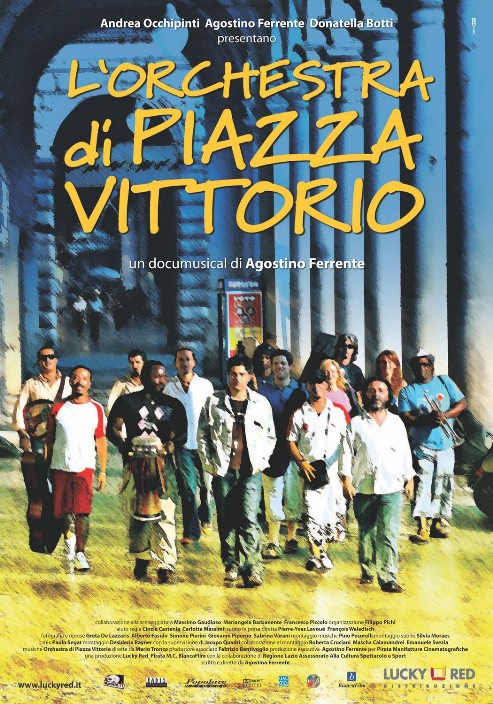EVENTS 2008 - Pentedattilo Film Festival
Main menu:
EVENTS 2008
ACTION WITH VITTORIO DE SETA IN PENTEDATTILO
Photo Installation
by Francesco Casciaro
Here we are after a few months from the production of Article 23 for All Human Rights For Hall to show some flash from the short film directed by Vittorio De Seta in the village of Pentedattilo. Guest in 2007 at Pentedattilo Film Festival, Vittorio taught us that cinema is not a gift package glazed and packaged with a ribbon and a red bow, he urged all young filmmakers to bring filmmaking back to its ethical function as an interpreter of contemporary reality. It is on that occasion that he was struck by the village, by its evocative power ... and he decided to shoot his short film there handing its production to young filmmakers: four minutes on the right-to-work. The flashes of our memory are fixed on the faces, the gestures, the cries out loud or through an often damaged bullhorn, the hugs, the sun beating down, the wind on the Ionian coast, the loading and the unloading, the tractors, the work plans being written, rewritten, and always not respected, the overlapping roles, the long nights talking through everything: how to organize the work, the budget, the misunderstandings, the hard work and the insomnia. But our memory runs especially to local people who were smiling, passionate and patient; who never refused, even at impossible hours, to give a hand to the young crew and the great Vittorio De Seta, the youngest of the young, perhaps because, consciously or not, in those days, those people lived, like us, the urge to tell in a short film the distress of yesterday and today’s emigration.
In Article 23 Pentedattilo becomes an additional emblem: from a symbol of forced abandonment it has now become, for local people, a welcoming land for the new South of the world . Well, we're almost at the end of our project, Articolo 23 will be premiered with the collective movie All Human Rights For Hall at Teatro Argentina in Rome on December 1st, and while being in full postproduction we want to offer through our friend Francesco Casciaro’s photographs what we have lived in these days here in Pentedattilo, because this micro-story has became part of Pentedattilo’s story, it testifies the adventure that sees the great filmmaker speaking the farmers’ language to young production realities which attempt to direct their action towards what De Seta calls "the ethical function of cinema". Thanks to PFF that welcomes our stolen pictures.
Maria Milasi Ram Film
Maria Furfaro Magafilms
__________________________________________________________________________________________________________________________________________________________________________________________________________
IL VANGELO SECONDO MATERA
Photo Installation
by Domenico Notarangelo
in partnership with Città del Sole Edizioni
The photographer and journalist Domenico Notarangelo accepted our invitation to install during PFF his extraordinary photographs taken forty years ago in Matera on the set of "Il vangelo secondo Matteo", Pier Paolo Pasolini’s masterpiece. Domenico Notarangelo, here with us at the festival, will meet the audience giving us the precious memories of his meeting with Pier Paolo Pasolini.
Participations: Domenico Notarangelo, Virgilio Fantuzzi, Franco Arcidiaco, Tonino De Pace, Americo Melchionda, Emanuele Milasi.
In the book edited by the publisher Città del Sole on the photo exhibition "Il Vangelo secondo Matera", Domenico Notarangelo talks about the experience which saw him involved in a relationship of friendship and collaboration with Pier Paolo Pasolini. His testimony adds new details about the great director’s thought and sensitivity, also suggesting a bold interpretation of the town of the "Sassi", which hosted the most important scenes of Jesus’ passion, death and resurrection: forty years ago Matera appeared as a new Holy Land, after Pasolini found there what he tried to find in vain in Palestine. Among the caves of the stones, instead, the greatness of the biblical landscape of Christ’s preachings still survived, there were also the light and the sounds of Jerusalem, and, most of all, there were the faces among which Jesus walked and to whom he turned two thousand years before to preach the new Word. Therefore, going there to shoot his "Gospel", Pasolini proposed Matera as Holy Land’s new role. And, as a matter of fact, his movie paved the way for other filmmakers in the following decades to set there their films on biblical themes. Like Mel Gibson, who shot "The Passion" in the same places forty years late . Notarangelo was not there on the set of the American director, it was his choice not to do so, perhaps in order not to contaminate the purity fo the memory he had been guarding inside his soul for so long. He preferred to collect the account of that experience from the voice of his son Antonio, who worked with Gibson. And from the photos taken by his son and the fellow-workers from Blue Video, he chose to combine some of them with some of his own taken in 1964, so as not to make a comparison or mark the differences, but to date two very different periods.
Franco Arcidiaco
Note sul libro "Il Vangelo Secondo Matera"
PASOLINI E LA CALABRIA
Comizi d’amore
In collaborazione con il Circolo del Cinema Cesare Zavattini
… Riparto, mi perdo nelle Calabrie, sempre più Calabrie… Non c’è dubbio, non c’è il minimo dubbio che vorrei vivere qui: vivere e morirci, non di pace… ma di gioia: … Comunque è chiaro che quello che si vocifera del Sud, qui c’è. Non è mica una chiacchiera che qui profumano zagare e limoni, liquirizia e papiri… Il mio viaggio mi spinge nel sud, sempre più a Sud: come un’ossessione deliziosa…"
Pier Paolo Pasolini
da "La lunga strada di sabbia", 1959
Nel 1956 Pasolini arrivò in Calabria invitato da Giacomo Debenedetti, " Ricevo un inaspettato invito a Crotone; benissimo, accetto proprio volentieri,…", e in seguito qui riceverà l’importante premio Crotone per Una vita violenta – che il Premio Viareggio aveva rifiutato - incontrando comprensione e ospitalità e trovando nel latifondo crotonese non solo l’ingiustizia di classe, ma anche una forza secolare capace di custodire il silenzioso paesaggio millenario e l’arcaicità della cultura contadina e di dare sfondo al primitivismo religioso del suo Vangelo. Qui scorse il volto " laicamente sacro" della sua giovane Madonna crotonese. Ma già per il suo reportage La lunga strada di sabbia aveva percorso le coste calabresi imbattendosi in quei volti di contadini – che Carlo Levi ritrasse nel suo famoso I tre di Cutro – che divennero i "banditi" di Pasolini e la dura polemica intorno all’etimo della parola che ne seguì, paradossalmente, rafforzò il suo rapporto con la Calabria, dove trovò gli amici di una vita. E dove tornò più tardi nel ’70 spingendosi fino a Reggio Calabria, per testimoniare ancora una volta con uno sguardo contro corrente una rivolta popolare "rimossa".
Con l’incontro di Ninarieddo (Ninetto Davoli" – "un ragazzo che è una morgana" – Pier Paolo Pasolini donò alla Calabria un suo segno d’amore, trovando e perdendo poi il suo "Alì dagli occhi azzurri", ma prefigurando con forza profetica un lontano futuro - ormai realizzato - per la nostra terra.
Lidia Liotta
circolo del cinema Cesare Zavattini
Proiezione del Film Il Vangelo Secondo Matteo di Pier Paolo Pasolini
Interventi: Virgilio Fantuzzi critico cinematografico
__________________________________________________________________________________________________________________________________________________________________________________________________________
SHORT FILM FROM POLAND
From Tofifest, Torun, Poland
Miasto Ucieczki by Woiciech Kasperski
Petla by Woiciech Kasperski
Pozna Noca by Jacek Banach, Przemek Komorniczak
Marco P. I. Zlodzieje Roweròw by Bodo Kox
Melodramat by Filip Marczewski
Kapelusz by Anna Smoczynska
Wszystko wg planu by Tadeusz Sliwa
Nie Wiem by Joanna Kaczmarek

__________________________________________________________________________________________________________________________________________________________________________________________________________
L’ORCHESTRA DI PIAZZA VITTORIO
Regia: Agostino Ferrente
Sceneggiatura: Agostino Ferrente, Massimo Gaudioso, Francesco Piccolo, Mariangela Barbanente
Montaggio: Desideria Rayner
Suono Silvia Moraes
Montaggio musiche Pino Pecorelli
Musica: l’orchestra di Piazza Vittorio diretta da Mario Tronco
Produzione Luchy Red, Pirata M.C, Bianca Film
Durata. 90’
Italia, 2006
Il film-diario della genesi della celebre Orchestra di Piazza Vittorio, band nata da un’iniziativa di Mario Tronco, il tastierista degli Avion Travel, e Agostino Ferrente, che, nel quartiere di Roma dove gli italiani sono "minoranza etnica" hanno riunito un gruppo di musicisti di strada (e non) che vengono da tutte le parti del mondo.
Quest’anno il festival si rilancia con la scommessa di cercare di entrare nella testa dello spettatore ma anche nel suo cuore.
In questo senso la presenza tra gli eventi del film L’orchestra di Piazza Vittorio di Agostino Ferrente è di quelli che colpiscono al cuore, di quelli che, con un documentario, hanno saputo amplificare, di un’Italia umile e nascosta, la voce dignitosa della multiculturalità. Il colore che non diventa folklore, il documento che narra, la musica che include, lo spirito di una città ("sapessi cos’è Roma" dice Pier Paolo Pasolini in un esergo alla fine del film) che racchiude in sé una e più nazioni.
Paolo Minuto
Presidente Federazione
Internazionale del Cine Club
Interventi: Massimo Gaudioso, Paolo Minuto
